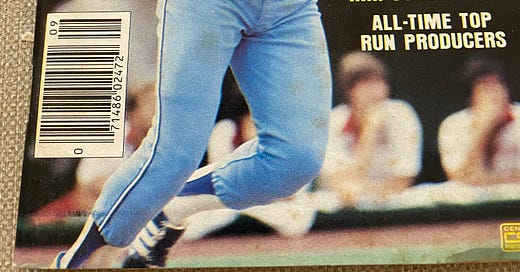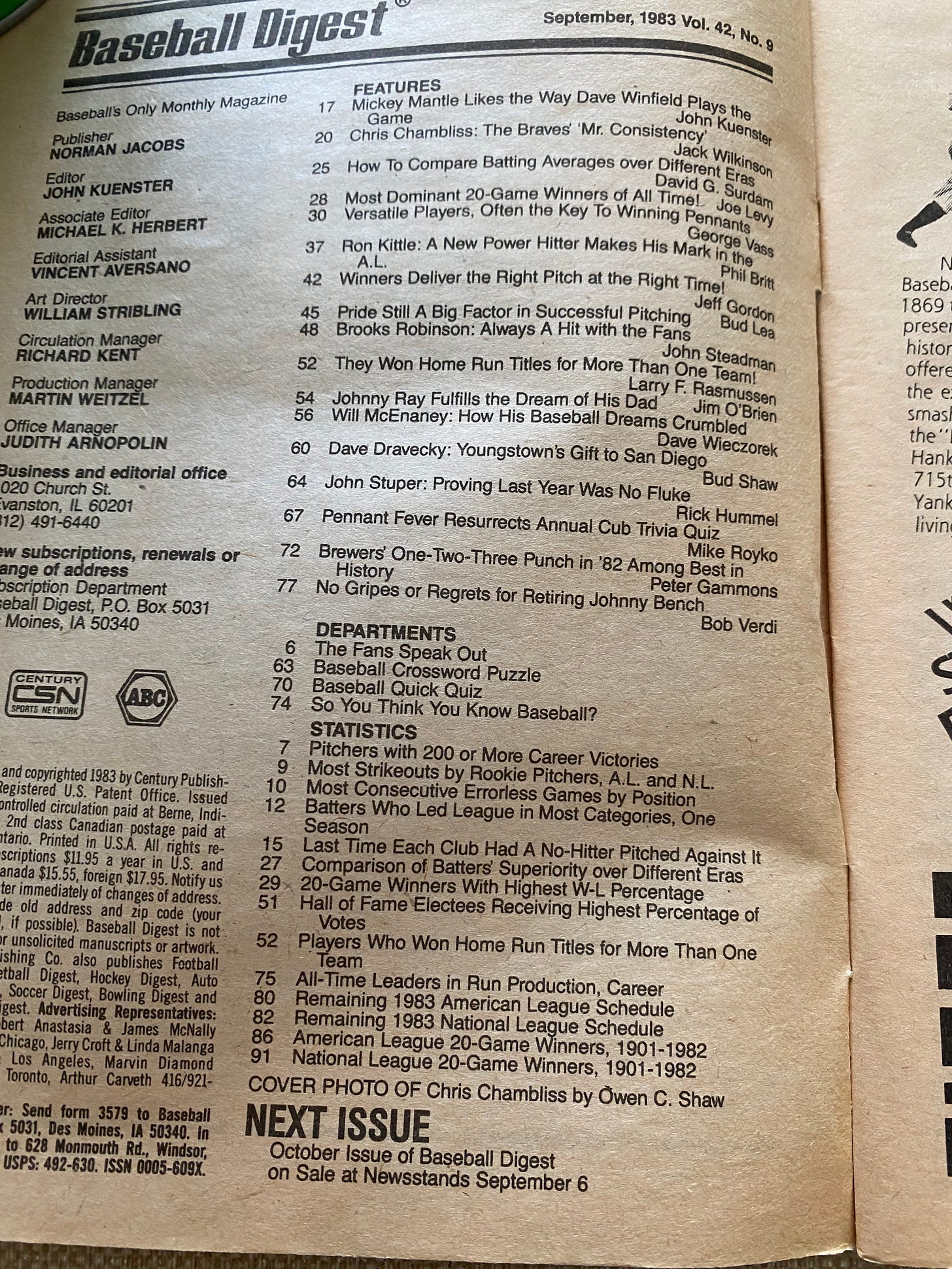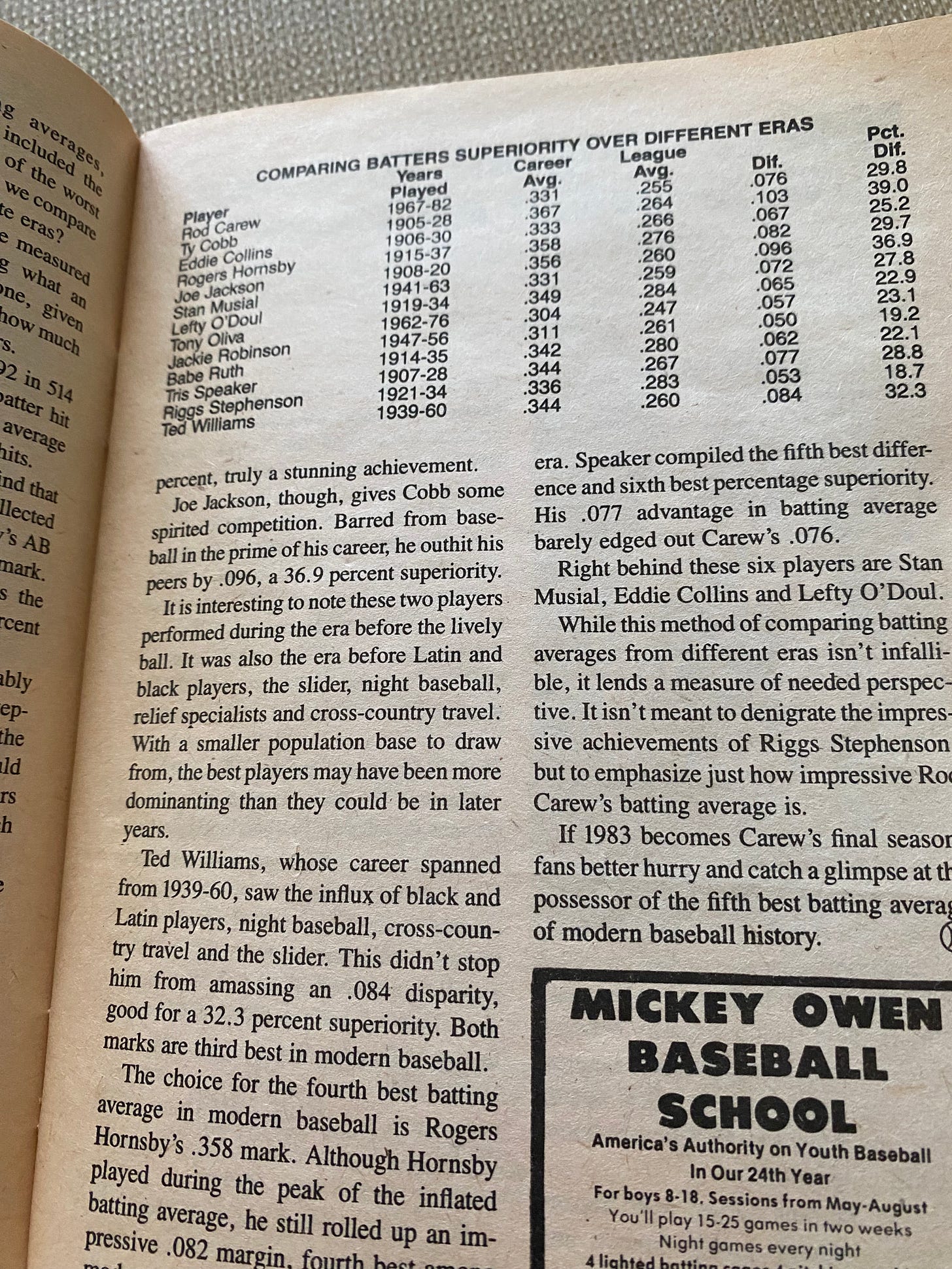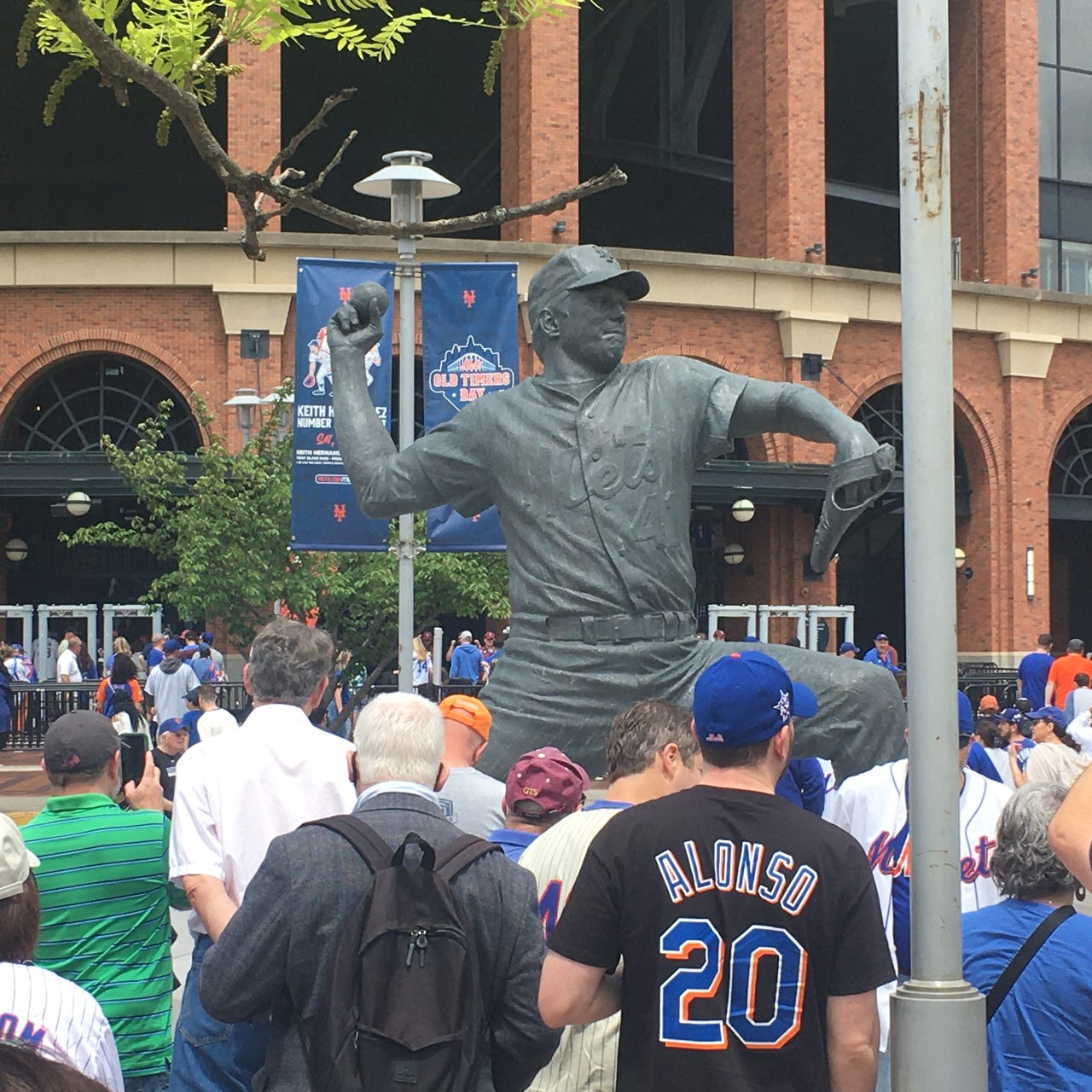September 1983
It is accurate to dub Chris Chambliss as “Mr. Consistency.” He quietly did his job day after day; he wasn’t the most crucial component of the Bronx Zoo era Yankees dynasty, but he was the exact type of steady performer that every winning team needs. That doesn’t even take into account that he hit the walkoff homer in the 1976 ALCS which gave that particular Yankees team their first pennant. That said, the timing was a bit off for this month’s cover feature. 1983 would prove to be his final productive season; decline kicked into full gear in 1984. 1983 would be the last time that his home run total hit double digits.
Two separate articles in this issue attempted to place statistics from different eras in perspective. I admire the attempt, but this being 1983 the stats which were used were rudimentary. Batting average as a basic metric tells you something, but not everything. The accompanying chart takes a random sampling of high average hitters and compares their career average to the league average in the years that they played. No surprise, Ty Cobb led in both total points and in percentage. As for the most dominant 20 game winners, that article simply lists the highest single season winning percentage for each pitcher. Ron Guidry’s 1978 season led that list, and while it is true that he dominated the league that year, there are probably better ways of measuring a pitcher’s superiority. Nice try, but not all that valuable.
The article on versatile players was not a prescient look at Ben Zobrist types years before the actual Zobrist reached the majors. It discussed the value of a player switching defensive positions to help improve the team. Yes, the history of the game is filled with such examples, but the subhead on the article lists 3 players to illustrate the point. Two of those examples are legit. Pete Rose’s switch to third base opened up left field for George Foster and completed the Big Red Machine. Paul Molitor’s switch to third base similarly solidified Harvey’s Wallbangers. The third example was Pedro Guerrero. Now, I loved watching Guerrero hit and despite the fact that he played in Los Angeles he was still one of the most underrated players of his time. But he bounced around different positions not because he was a versatile defender willing and able to play wherever he could best help his team. He switched because he was an absolute butcher on the field and the Dodgers were constantly trying to find a place to stash him where he could do the least damage.
Mike Royko’s contribution to this issue was a Chicago Cubs trivia quiz which poked fun at the many lowlights in team history. Sample question: In 1958, Cub rookie Tony Taylor crossed himself and said a prayer every time he came to bat. What did this devout lad hit that year? Taylor hit .235 and Royko pointed out that the perpetually hungover Hack Wilson hit 56 home runs in 1930. Let that be a lesson.
Finally, it’s always worthwhile to read the work of Peter Gammons. He attempts to historically rank the Milwaukee Brewers top 3 of Paul Molitor, Robin Yount, and Cecil Cooper. He quotes famed statistician Pete Palmer, who states that his methodology ranks those Brewers 13th all time. (#1 was the 1948 Boston Red Sox - Dom DiMaggio, Johnny Pesky, and Ted Williams.) This is an impressive stat on that Brewers trio - they ranked 1,2,3 in the AL in hits during the 1982 season.
The Hall Of Fame Cap Project - 19th Century Players
As it turns out there are very few players from the 19th century who actually have cap logos on their Hall of Fame plaques. Of course, a lot of that has to do with the fact that cap logos were not yet commonplace at the time, so in many instances there aren’t any logos to use in the first place. So, a plaque rethinking would also necessitate someone retroactively designing some logos. Here are my picks for the correct player/team matchups.
Baltimore Orioles (3): Hughie Jennings, Willie Keeler, Joe Kelley
Boston Beaneaters (2): Hugh Duffy, Kid Nichols
Boston Red Stockings (2): Jim O’Rourke, Deacon White
Buffalo Bisons (2): Dan Brouthers, Pud Galvin
Chicago White Stockings (3): Cap Anson, John Clarkson, King Kelly
Cincinnati Reds (1): Bid McPhee
Cleveland Spiders (2): Jesse Burkett, Cy Young
New York Giants (5): Roger Connor, Buck Ewing, Tim Keefe, Amos Rusie, Mickey Welch
Philadelphia Phillies (3): Ed Delahanty, Billy Hamilton, Sam Thompson
Providence Grays (2): Old Hoss Radbourn, John Montgomery Ward
St. Louis Browns (1): Tommy McCarthy
Only 5 of these men have cap designations on their actual plaques. Keeler is in as a Dodger and Hamilton & McCarthy are both Braves. I stand by my Keeler and Hamilton choices; McCarthy is high on the list of most undeserving members of the Hall, so I can simply throw a shrug emoji towards his plaque. Does it really matter which team he represents? Jennings has a Tigers cap, which is odd. He was a successful Tigers manager for years, but he was inducted as a player, not as a manager. The only instance in which my selection matches the actual plaque is Cy Young, which is kind of hilarious. The winningest pitcher in baseball history has a close connection to the franchise that had the worst single season record in history. Even better, Young’s final season with the Spiders was 1898, the year before they put together that horrible season. If only Young was still a Spider in 1899…
50 Years Of SNL Music
Even with 3 hours of running time to play with (more accurately a shade over two hours once commercial breaks are taken into account) it’s impossible to fully cover everything in NBC’s recent special which examines the history of music on SNL. There are a few glaring omissions (G.E. Smith was bandleader and musical director for a decade, yet he is not mentioned at all) but overall the show was a satisfying summary of a half century worth of musical moments.
Shortly before the special aired, the opening montage went viral and deservedly so. Questlove co-directed the special and also compiled the montage and it seamlessly mashes dozens of musical performances together. I can’t comprehend the number of hours it took to plan this and then actually piece it all together. I used to work at a video post production facility. I was on the sales end, not a technician, but I saw enough to know how time consuming the process of editing is. Magnificent work.
Allow me to mention two other omission that slightly disappointed me. The special acknowledged that Billy Preston was the very first musical performer in SNL history, but the premiere episode actually had two musical guests. There was no mention of Janis Ian’s significance in show lore. There was also discussion about that the fact that in the early years the show often booked musicians that were decidedly out of the mainstream - Sun Ra for one example. In my eyes the quintessential musical act of the first 5 seasons was Leon Redbone. A bluesy singer who specialized in covering decades old material, it’s impossible to imagine the 2025 equivalent of Leon Redbone, whomever that might be, appearing on the show today. I would have loved to have seen a clip of him in the show.
I enjoyed hearing stories that I was either unaware of, or had forgotten about. A case in point was the tale that Tom Morello told about the night that Rage Against the Machine performed. In one of the worst host/musical act bookings imaginable, they appeared on an episode that Steve Forbes hosted. The anecdote involved their intention to drape an upside down American flag on an amplifier and culminated with the Secret Service escorting the band out of 30 Rock. Morello punctuated the story by saying that despite the brouhaha he still attended the afterparty.
There was also an extended segment devoted to the infamous appearance by hardcore band Fear. At the time there were hysterical news reports about alleged riots on stage, but looking at the clip through a fresh set of eyes it’s obvious that the response was due to the fact that gatekeepers had no idea what slam dancing looked like. There was nothing about the actual performance that looked like a riot. Remember, this was the era in which people were convinced that The Plasmatics were the downfall of society.
The special did not discuss every controversy, but there were focuses on Elvis Costello and Ashlee Simpson. And yes, Sinead O’Connor, in an example of time healing all wounds. Lorne Michaels was livid for years over her Pope photo-tearing protest. For years he refused to license the footage; anyone wishing to include the incident on a news piece were limited to showing still photos of her performance. Her appearance plays a lot differently now; the purpose of her actions was to protest the Catholic Church’s coverup of child sex abuse. Time has vindicated her.
This is not to say that the special overly focused on controversies. Most of the show discusses the close connection between SNL and rock & roll. It wasn’t always easy to find rock music on network television in 1975, and there is a long list of legends who have appeared on the show over the course of the last 50 years. Many of these artists made their national TV debuts on the SNL stage. Furthermore, as much as the show has often had an awkward history with race it was also instrumental in helping introduce hip-hop to a white audience.
It’s not just about the musical performances either. There are lots of great clips of famous musicians acting in sketches - who else remembers the commercial parody for the camera that is so simple even Stevie Wonder can use it? There are features on several memorable music related sketches - James Brown’s Celebrity Hot Tub, Lazy Sunday, etc.
Music has been such an integral component of SNL. The final pre-50th anniversary show celebration will be an all-star concert taking place this Friday evening at Radio City. It will stream live on Peacock. I’m looking forward to that one; I’ll share my thoughts on that next week.
One On One
I have watched a handful of games in the inaugural season of Unrivaled, and as we are roughly at the halfway point my preseason assumptions have basically held true. The action is fast paced and the intensity of the competition is at a high level. The fact that the games are 3x3 rewards versatility; with only 6 players on the court you can’t easily hide someone who’s weak defensively.
On the other hand it’s still a challenge to establish any rooting interests. Because everything is starting from scratch I have to constantly remind myself which players are on which teams. If I look at a TV listing and see that the Lunar Owls are playing the Mist it means nothing to me. It’s not until I actually tune into a game that I can connect a player to a team and I then quickly forget until the next time I watch. I don’t know if that’s a me problem or a structural problem with the league, but it’s an issue.
That issue will not exist with the event that is beginning tonight. The schedule is taking a weeklong break for 1 on 1 single elimination tourney which tips off this evening. That should make for some exciting play; it’s played with make it, take it rules so there is a chance that a player can find the hot hand and really go off. The champ will be crowned on Friday; I’m hoping for some terrific action.
TV Of the 21st Century - Arrested Development
You may have noticed by now that I can’t stand comedies that are reliant on overusing catch phrases. Arrested Development is a perfect example of the reverse. There have been few shows as quotable as this one, yet with few exceptions the top notch quotes were only heard in one episode. And the catch phrases that did recur did not pop up in every episode. Gob made a countless number of huge mistakes over the years, but he did not say “I’ve made a huge mistake” each and every time.
AD spent 3 seasons (plus 2 more on Netflix that we need not speak of) chronicling the foibles of the Bluth family, a wealthy clan who saw their comeuppance through a combination of criminal activity (some light treason) and utterly vapid stupidity. In a tribute to the writing and to the actors, we fell in love with these characters no matter how awful they often behaved. As Stefon would say, this show had everything - a banana stand, a model house, a stair car, the Blue Man Group.
For a show with such a deep bench of memorable characters there are still clear gold, silver, & bronze medalists. I’ll leave it up to you to decide the precise hierarchy, but the big 3 are characters for whom virtually every line out of their mouths is a guaranteed laugh riot.
One would be Tony Hale as Buster. It’s difficult to properly describe him in a way that would do him justice. The ultimate mother’s boy, he is teeming with neuroses of all types. Too bad for him about that loose seal. Speaking of mothers, Jessica Walter as Lucille was a true treasure. Hateful, spoiled, and perpetually soused, she could say as much with a wink as any other actor could say with a page long soliloquy.
If you forced me to make a decision, the star of stars was David Cross as Tobias. Arguably the most clueless character in TV history, he had a talent for unintentionally saying the most humiliating things possible, usually of a sexual nature. Let’s just say he didn’t think things fully through when he decided to combine the techniques of analysis and therapy.
The bench of recurring characters was just as talented and deep as it was for the regulars. More than anything else his run on this show was responsible for the spectacular second act of Henry Winkler’s career. And who knew that Liza Minnelli could be so self deprecatingly funny? Also, Ron Howard’s narration was pitch perfect. That’s not to mention Judy Greer. Or Julia Louis-Dreyfus. Or Ed Begley Jr. Or Charlize Theron. And so on. And so on.
After 3 low rated seasons Fox cancelled the show but it had built up a huge cult following and Netflix green lit a revival nearly a decade later. The revival had its moments, but it suffered from one big problem. All of the actors were so busy on other projects that it was impossible to gather them all together at the same time, so they often acted solo. The ensemble feel was gone; something crucial was missing as a result. It didn’t help that the premiere of the second season of the reboot coincided with allegations of Jeffrey Tambor’s poor behavior. It made for some uncomfortable moments during the press run. The male members of the cast largely circled the wagons and defended him in public, as Jessica Walter quietly seethed.
The show has gone on to inspire countless memes and has provided us all with some valuable life lessons. There’s always money in the banana stand. And Carl Weathers taught us all how to get a stew going.
Originally aired on: Fox
Currently streaming on: Netflix
Closing Laughs
OK you good people, that will be enough for today. Have a fantastic week everyone, and thanks as always for subscribing. Be sure to tell your friends that all are welcome. Oh, and be thankful that you’re not Drake. See you on Wednesday.








